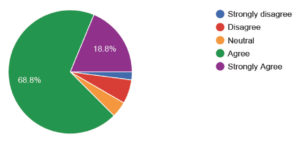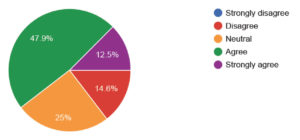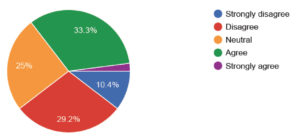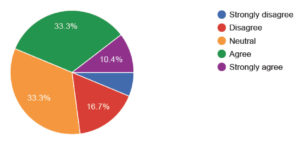Student Presentations in a large class setting
July 2019
LSM2233 Cell Biology 2018/19: For the first time we tried to do group presentations in our large class of 127 students! It was far from perfect, but there was lots to learn from it, which I wrote about in this article (download pdf version):
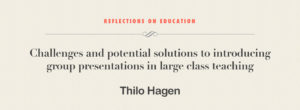
The ability to acquire knowledge independently is one of the most important skills that students in tertiary education should attain. Gaining independent learning skills helps students to be well-prepared for the constantly changing employment environment that they will face in the future. One of the most common approaches to develop independent learning skills is to flip the role of teacher and student and let the students present independently acquired knowledge to the class.
However, this approach has been difficult to achieve in large class settings. With large numbers of students, there are time constraints to let all students present and to evaluate the whole class. It is also difficult to provide feedback. There may be lack of attention by the student audience or a low quality of the student presentations, making it difficult to achieve effective learning for the non-presenting students.
One approach to address some of these concerns is to conduct the presentations in student groups. Group work can decrease the amount of time needed for in-class presentations and may also potentially improve the quality of the presentations, both in terms of content and delivery. Conducting the activity in groups also helps the students to develop another important skill – the ability to work in teams.
Hence, with the aim to improve independent learning skills and help students to develop transferrable skills in presenting in front of a large audience and in working in groups, I introduced a group-based, student-led presentation component into a Year 2 life science undergraduate course. In this assignment, I tried to achieve the following learning objectives:
- Acquisition and application of knowledge by both the presenting students as well as the student audience
- Development of skills to independently acquire knowledge
- Learning to productively engage with team members
- Development of presentation skills.
Below I describe the implementation and outcomes, based on evaluations by the lecturer and survey-based feedback from students.
IMPLEMENTATION
A student-led teaching component was introduced into a Life Science Year 2 course (class size 127 students) in the second semester of Academic Year 2018/2019. The component covered one of the major topics of the course (cell cycle and cell proliferation, spanning four 90 min lecture sessions).
The activity was carried out in groups of three students. The students were assigned into groups of three students at the beginning of the semester. The assigning of the groups was carried out by the instructor, based on a short survey that the students completed at the beginning of the semester. In the survey, the students were asked about their gender, year of study, major and approximate previous academic performance (e.g. first class, second upper class or second lower class). They were also asked to describe themselves in one or two words. The instructor then tried to assign teams that were mixed in terms of gender, year of study, major, academic performance and personality type (extrovert versus introvert). The students performed various graded and non-graded in-class activities throughout the semester in their groups. Hence, the students were already familiar with their group members when the presentation assignment was announced.
In the presentation assignment the student teams had to prepare and give 4 min presentations related to the topic of the cell cycle and cell proliferation. The presentation timing was chosen with the purpose to allow all teams to present. The design of this component was informed by a video assignment, which I have included in the same module for many semesters and which has produced excellent results. In the video assignment, students individually choose a specific question or problem, related to a provided general topic. The students then individually prepare a 3 min video. The majority of the students produce highly engaging, interesting, informative and very clear video presentations.
Due to the established success of the video assignment, I tried to use a similar approach for the group-based presentations. Thus, I asked the student groups to choose a topic by themselves based on a specific question or problem, and upload their chosen topic. I then checked the topic for suitability and any duplication with other groups and approved the topic. There were a number of reasons why I decided to let the student groups choose their own topic was. Firstly, I intended to give the student more autonomy with the goal to increase student motivation. Furthermore, I reasoned that letting the student groups identify a scientific question or problem would promote the development of analytical and decision-making skills as well as team-working skills. It was also my intention to let the students make connections between the presentations and fit the information into a bigger picture. In other words, I tried to avoid “spoon-feeding” the student audience by organizing the presentations in a systematic manner. However, ultimately it was concluded that letting the students choose their own topic is problematic (see below).
The student teams also had to come up with two application-based multiple choice questions (MCQ) based on their presentation content. These questions were then answered by the rest of the class individually via the University learning management platform. This MCQ component was graded. Questions with a lower level of difficulty had to be answered immediately after each presentation, whereas for more difficult questions 36 hours of time was given. (The detailed instructions and grading criteria for the assignment are listed in the appendix). The purpose of the multiple-choice questions was to promote application and conceptualization of the information conveyed by the presenters. The MCQ also motivated students to attend and pay attention to the presentations.
It should be emphasized that the described approach was a challenging activity, which was different from commonly conducted group presentations in science courses. Firstly, the presentations took place in a large-class setting. Secondly, the student groups had great autonomy over their presentation topic and presentation style. Other differences to common presentation assignments included the task to design and answer application-based MCQ and the short presentation time of 4 minutes.
EVALUATION
To evaluate the achievement of the intended learning objectives, an anonymous online survey was conducted after the component, which is presented below, along with some evaluations and reflections by the instructor.
In the survey, students were asked to rate the level of agreement with four questions about the knowledge and skills acquired. The students were also given the option to give any examples or comments. There were 48 student responses out of 127 students taking the module (37.8% response rate).
QUESTION 1. I learned new knowledge while preparing and giving my presentation and setting up the MCQ.
Strongly agree: 18.8%
Agree: 68.8%
Neutral: 4.2%
Disagree: 6.3%
Strongly disagree: 2.1%
The survey results suggest that the students felt that they had gained knowledge from preparing their own presentations. In agreement with this, based on the evaluation by the instructor, it was apparent from the presentations that the majority of students was able to acquire new knowledge independently and make logical connections between different processes. There were also a number of useful comments. Some students pointed out that the preparation for the presentation helped them to gain deep knowledge in one particular area. This is because in order to give an accurate presentation of a concept or pathway to the student audience, the presenting students had to have an in-depth understanding. Thus, one of the students commented: “I need to learn about my given topic well enough before I can present it to my peers in an understandable manner.”
QUESTION 2: I gained useful skills from preparing and giving the group presentation and setting up the MCQ.
Strongly agree: 12.5%
Agree: 47.9%
Neutral: 25.0%
Disagree: 14.6%
Strongly disagree: 0%
When specifically asked about the acquisition of skills from preparing and giving the group presentation and setting up the MCQ, students were less positive. This result was unexpected and disappointing, given that one of the main learning objectives of the assignment was the development of transferrable skills, such as independent knowledge acquisition, working as part of a team and presenting in front of an audience. Reasons that may have contributed to the students’ perception are the lack of guidance, lack of feedback and lack of opportunities for improvement. On the other hand, the intended development of transferrable skills is not a traditional learning outcome in most University courses. Hence, it is possible that the students did not recognize the importance of these skills and underestimated and undervalued skills-based learning outcomes.
Nonetheless, compared to the normal lecture-based learning, the students clearly needed to learn and apply different skills. Several students mentioned that the assignment helped them to gain experience in presenting and to improve presentation skills. For many students it was likely also one of the first assignments in which they had to independently answer a scientific question. Furthermore, the opportunity for students to experience the challenges of presenting in front of a large audience and to come up with clear and relevant test questions should also not be underestimated. Experiencing the challenges of a task is often is an important first step in achieving mastery.
Finally, a useful outcome of the assignment was likely that it helped students to develop skills to work in a team, through peer instruction, providing feedback, argumentation and collective decision-making. However, as is common in group work activities, the group dynamics, attitudes of group members and outcomes in terms of learning and skill acquisition varied greatly between groups. For instance, one student remarked that “… group work was minimum as we all did our parts …”.
Some measures were introduced to promote a successful outcome of the group work. For instance, before the group presentation assignment, the groups carried out smaller in-class activities. These in-class activities likely promoted the engagement of all group members and helped in team-building. To balance gender, academic performance and personality type (i.e. extroversion and introversion), the groups were assigned by the instructor. This was achieved through a mini-questionnaire, which the students completed during the first week. Finally, the group size was kept small in order to increase student accountability.
Nonetheless, based on the literature, additional measures could be introduced to promote participation by all group members and improve the outcomes of the group-based work (Soller, 1998; Yamane, 1996). One approach to promote participation is to initiate the project during class time and to provide a structure that ensures that each group member participates (Soller, 1998). For instance, a potential task would be to ask each group member to come up with a presentation topic and then present their proposal to the other group members. During this initial discussion, roles can be assigned to individual students (e.g. explainer, questioner, and evaluator).
It would be even better if a greater proportion of the group work could be scheduled during class time. If that is not possible, an alternative approach proposed by Yamane (1996) is to get the students to report their free time for group work at the beginning of the semester and assign groups according to available time slots.
Another approach is to assign roles to group members throughout the entire project duration. For instance, group member roles could include a meeting organizer, a presider (who sets meeting agendas), and a progress reporter (who updates the course instructor) (Yamane, 1996). The lecturer could ask the progress reporter to update him or her about the progress with the assignment, but also about whether all members are contributing to the project, whether there are any personality conflicts that hinder the progress and whether there is any help that the lecturer can provide. These measures would likely increase student accountability.
The instructor or the teaching assistants could also meet up with individual groups to discuss progress in the project as well as any problems that the students have encountered as a group. However, if sufficient teaching assistants cannot be recruited, implementing individual meetings could be challenging in the large class setting.
Finally, the group assignment could include two components. In one component the students are evaluated as a group and in the other component on an individual basis (Yamane, 1996).
Ultimately, a group project is successful if the students achieve true collaboration and interdependence and if they consider success as a joint achievement (Soller, 1998). This is not a default outcome that will happen in group-based learning, but a result that requires planning and directed intervention by the lecturer.
QUESTION 3: I learned new knowledge from the presentations of my peers and answering their MCQ.
Strongly agree: 2.1%
Agree: 33.3%
Neutral: 25.0%
Disagree: 29.2%
Strongly disagree: 10.4%
This statement showed the highest level of disagreement by the students. The unfavorable response to this question reflects the overall lower than expected quality of the presentations. There were in fact only a few very good presentations. The relatively low quality of the presentations made it difficult for the audience to gain much new knowledge during the sessions. The comments by the students were also very consistent. The students pointed out that the presentations were not clear, did not contain enough background information and covered too much content. Therefore, the objective that the students learn new knowledge from the presentations was not met.
Based on the evaluation by the lecturer, the main reason for the ineffectiveness of the student presentations was not the delivery of the presentation. The main problem was related to the structure and content. For instance, the students provided insufficient background information. There was too little focus on the main topic and too much detail on facts and findings that were not relevant for the main topic of the presentation. There was also a lack of summaries.
One possible reason for the unsatisfactory quality of the presentations is the lack of clear instructions and examples, which the students can emulate. Another reason is likley related to the presentation topics. One student commented “… I did realise that whenever there were overlaps in some topics, it was easier to follow the speaker! Perhaps, an order which leads up from basic understanding of the cell cycle to application of that knowledge might be a better way to reinforce our learning as well.” This comment is indeed valid, and the experience of the sessions has shown that it is preferable that the topics are chosen by the instructor in a logical and overlapping order. This is likely to ensure that the audience is able to follow the presentations better and gain new knowledge.
The disappointing quality of the presentations and the unsatisfactory learning experience are likely also due in part to the lack of feedback. Based on my own experience in other courses, providing feedback to students about their presentations and giving students the opportunity to present an improved version increases the presentation quality dramatically. However, feedback by the instructor may be difficult to provide in the setting of a large class. Instead, it would be possible to use a peer feedback approach. For instance, student groups could be paired up to provide peer feedback prior to the presentation. This may improve the quality of the presentations.
QUESTION 4: Although I learned much less factual knowledge compared to normal lecture based teaching, the skills learned during this part of the module will be more useful in the long term.
Strongly agree: 10.4%
Agree: 33.3%
Neutral: 33.3%
Disagree: 16.7%
Strongly disagree: 6.3%
Some of the positive outcomes mentioned by the students included getting used to reading through content heavy research papers and developing the skill to pick and choose information from credible sources. The sessions also helped to improve presentation skills and recognize the challenges of presenting in front of a large audience and capturing students’ attention.
Overall, there were more students who agreed with the statement that useful skills were learned compared to students who disagreed. Nonetheless, there were various students who expressed that they learned no significant additional skills during the activities.
Some students also pointed out that the sessions did not help to establish a foundational knowledge in the covered topics. The students felt that this may impede their preparedness, understanding and performance in future modules. While it is important to improve the quality of the presentations, in response to these comments, it is also important to highlight to the students the importance of gaining independent learning skills. This is often not appreciated by the students (a common student comment: “We have to do the work of the teacher.”). It is also important to explain the learning outcomes more clearly.
To explain the learning outcomes, I have prepared videos, which the students watch at the beginning of the semester. In the videos, I discuss the intended learning outcomes of the course and how the individual components of the course contribute to achieving these outcomes. I also explain why these learning outcomes are important for their future. Nonetheless, I have also realized that the main motivation for students in most modules is to do well in the final exam. Hence, it would be ideal to link the presentation topics more directly to the final exam.
Setting of multiple choice questions
One component that was meant to help the students to develop independent learning and problem solving skills was the setting of application-type multiple choice questions (MCQ) based on their presentation. It can be argued that students learn more from setting MCQ’s than from answering them. When setting an MCQ, one would usually start with the answer, and come up with possible ways to get to this answer. This is much more similar to the real life situation where one often has to find an explanation for a problem.
Another reason for including (graded) MCQ after each presentation was to increase student attendance and attention level, which was indeed achieved. The MCQ greatly increased the engagement of the students in the audience. It was also acknowledged that setting of MCQ by the presenting students was helpful in deepening the concepts learned during the preparation of the presentation. However, the same is likely not the case for the audience, who often did not acquire enough knowledge (due to poor presentation quality, lack of attention or prior knowledge) in order to answer the questions. Furthermore, given that the questions were expected to be application based, the students tended to come up with very complicated questions. Of note, one student made the excellent suggestion to “have students explain the answers to their questions, so they do not just think about setting hard questions but rather, questions that really test our understanding.” This is indeed an excellent proposal that would likely address some of the MCQ related difficulties.
An important point to consider is whether the students need to answer the MCQ immediately after the presentation or whether time is given to the students to answer the questions after the lecture. Both approaches have their advantages and disadvantages, as highlighted in the table below.
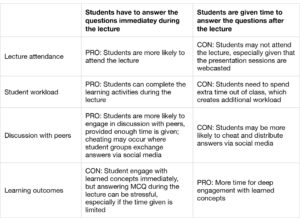
Table 1: Advantages and disadvantages of submitting of MCQ answers during or after the lecture.
In my sessions, I used a combined approach, letting students answer easier questions during class and more difficult questions out of class. However, given that the time given to answer the MCQ in-class was limited, a number of students commented that answering the MCQ in-class was stressful. Hence, to promote student learning, it is recommended to let the students answer the MCQ after the class.
Cheating
As mentioned in the table, one problematic issue is cheating by distributing answers via electronic media and social media. According to comments by students, cheating occurred for MCQ that had to be answered both in class and out of class. Specifically, students forwarded the answers to the multiple choice questions that they set to other students. The answers were primarily sent to their friends, illustrating the well-known fact that cheating is more common among groups of friends.
It is also well-known that the question format (MCQ) is particularly susceptible to cheating. Answering short answer questions is much less likely to elicit cheating behavior. However, as mentioned above, one major objective was that the presenting students apply what they have learned by coming up with questions. And setting of high quality, application based MCQ is intellectually more challenging compared to coming up with short or long answer questions. Hence, setting of MCQ likely met the learning objectives of the assignment better.
The best way to address cheating is likely to discuss this issue during the class, where the lecturer communicates his/her expectations clearly (Tatum and Schwartz, 2017). This includes making it clear to the students what kind of collaboration and group work is appropriate and what kind of work constitutes cheating. Communicating expectations is important because students often have different views and preconceptions about which behavior is acceptable and which is not. For instance, students often view cheating via electronic means as less severe (Tatum and Schwartz, 2017). Furthermore, it has been shown that students without a clear perception of what constitutes cheating are more likely to engage in cheating behavior (O’Neill and Pfeifer, 2011).
It is also a good practice to include at the beginning of an assignment a question where students need to confirm that they have not cheated (for instance in the case of the described assignment, “I did not distribute my MCQ answers”, or “I did not receive any MCQ answers”). This is a reminder to students of what the expectations for the assignment are.
Academic honor codes are also well known to reduce cheating behaviour. The National University of Singapore does have an honor code and the students sign a pledge to abide with this code. However, according to Tatum and Schwartz (2017), a traditional honor code includes in addition to the honor pledge also a peer-reporting requirement, a student-run adjudication system, and a requirement that faculty turn all suspected cases over to the judiciary body. Nonetheless, it is a good practice to remind students of their honor code pledge before the assignment.
Addressing cheating when it has occurred is important, as it has been shown that the strongest predictor for cheating is witnessing of cheating by other students (O’Rourke et al., 2010; McCabe & Trevino, 1993). Based on the honor code described above, it can be considered to appoint a student committee (student honor council) at the beginning of the semester. In the event of any reports or rumors of cheating, the honor council investigates any cheating behavior and breaches in the honor code that the students have committed. This committee could then make recommendations to the lecturer to deal with the cheating behavior. I have indeed appointed such a student committee in the subsequent semesters and to the best of my knowledge, no instances of cheating occurred. In the following semester, where I did not appoint a student honor council (given my expectations that the type of assignments and assessments are not likely to incite cheating behavior), cheating in fact did occur again. In conclusion, it appears that appointing a student honor council is always a good practice.
RECOMMENDATIONS
Based on the student feedback and my own reflections on the assignment, I conclude with the following recommendations for the successful implementation of group presentations into a large class module.
Recommendations for group presentation in large group classes:
- It is important to explain the intended learning outcomes clearly at the beginning of the assignment. The content and skills learned in this component should be relevant for the final exam.
- It is necessary to give clear instructions for all assignment components. Specific examples should be provided.
- The presentation topics should be chosen by the lecturer and be presented in a logical manner, with overlapping and recurring content, to help students built on learned knowledge and extend learned concepts. It is recommended to familiarize students with the core concepts before the presentation sessions through some reading assignment or a video.
- It is recommended to pair up the groups to provide peer feedback prior to the presentation.
- It is recommended to let the students set application-type MCQ based on their presentation, which are to be answered by the students in the audience in a take-home assignment (to prevent time pressure). Importantly, the answers to the MCQ should be explained by the presenting students.
- To prevent cheating, the lecturer should clearly explain the expectations at the beginning of the assignment, and remind the students of their pledge to abide by the honor code. To address cheating when it has occurred, it can be considered to appoint a student honor council at the beginning of the semester, which investigates any alleged cheating behavior and makes recommendations to the lecturer.
In conclusions, presentations in a large class setting are possible. They help the presenting students to engage in depth with the material. If conducted in the right way, it is an approach that can get all students, presenters and audience, involved.
REFERENCES
McCabe DL, Treviño LK. Academic dishonesty: Honor codes and other contextual influence. (1993) Journal of Higher Education 64:522–538.
O’Neill HM, Pfeiffer, CA. The Impact of Honor Codes and Perceptions of Cheating on Academic Cheating Behaviors, Especially for MBA Bound Undergraduates. (2011) Business and Economics Faculty Publications. 14.
O’Rourke J, Barnes J, Deaton A, Fulks K, Ryan K, Rettinger D. Imitation is the sincerest form of cheating: The influence of direct knowledge and attitudes on academic dishonesty. (2010) Ethics & Behavior 20:47–64.
Soller A, Goodman BA, Linton F, Gaimari R. Promoting effective peer interaction in an intelligent collaborative learning system. (1998) In B. P. Goettl, H. M. Halff, C. L. Redfield, & V. J. Shute (Eds.), Proceedings of the 4th International Conference on Intelligent Tutoring Systems (ITS 1998) (pp. 186–195). Berlin: Springer.
Tatum H, Schwartz BM. Honor Codes: Evidence Based Strategies for Improving Academic Integrity. (2017) Theory Into Practice 56:129-135.
Yamane D. Collaboration and Its Discontents: Steps toward Overcoming Barriers to Successful Group Projects. (1996) Teaching Sociology 24:378-383.
APPENDIX
Instructions for the group based presentation assignment:
Instructions for group presentation:
For the cell proliferation/cell cycle component, each group needs to give a 4 min presentation on a chosen topic and come up with two MCQ, which will be answered by the whole class after each presentation. The marks for this component will be made up of:
- presentation: 4.5% (team marks)
- MCQ setting: 2% (team marks)
- MCQ answers: 10.5% (individual marks)
Topic: I would like you to choose one specific application question.
The question should start with “Why…?” or “How…?”
I have uploaded a number of examples in this google document:
- Why is knockout of Cdk1 embryonically lethal?
- How does the anti-cancer drug taxol kill tumor cells?
- Why does knockdown of Cdh1 and Cdc20, which are part of the same Anaphase Promoting Complex, have different effects on the cell cycle?
- Why does a mutation in RAS promote tumor formation?
- Why does DNA damage, induced by gamma-irradiation, lead to cell cycle arrest?
If you want you can choose these topics (only one team per topic) by indicating your team number besides the topic, or choose a new topic and submit it into the google document with your team number. Try to choose a topic that is different from those that have already been chosen. I will check the topics a few times daily and approve them if ok. If you really cannot find a topic yourself, you can email me and I will give you one.
It does not matter what sources you use to prepare your presentation (textbook, research papers, or other internet resources). When preparing the presentation, assume that the class has some basic knowledge about DNA and the cell cycle, but otherwise only knows what was taught in this course (in other words, do not refer to or build on what other teams may present). Do not worry about duplication of content. Every presentation will be evaluated independently based on its own merits. You do not need to send me your slides beforehand, but please upload them onto the desktop in the LT before the lecture.
Who needs to present: This is up to you. You can all share the load or nominate one or two presenters. All team members will obtain the same mark.
Marking: The criteria are 1) What is the scientific quality of the presentation; 2) How clear/easy understandable is the presentation; 3) How interesting is the presentation;
The marks will be made up to equal parts of assessment by myself, by one co-lecturer and by the audience (you).
Instructions for MCQ setting:
Your two MCQ should be based on your presentation. You need to submit them at least 24 hours before your presentation slots to me via email. The questions should have at least 3 answer options and can have one or multiple correct answers. Please indicate the correct answer(s)! Myself and the co-lecturer will evaluate your MCQ after your presentation. The main criterion is whether the question manages to test the student’s understanding (understand and apply what you have explained). Questions which only test whether the students remember facts from your presentations will not be ideal. The questions can contain a figure (but this is not a must!).
MCQ answers:
After each presentation, we will give you a chance to cast your vote for the quality of the presentation. We then flash up the 2 MCQ and you can answer them individually via IVLE. We will count your average score of the best 3 out of the 4 sessions/lectures (so you can miss one lecture).
